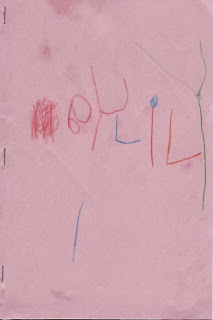 |
| By Lily, [Book] 1 |
 |
| "The title is Color." |
 |
| Page left: "First the little girl and her daddy woke up." Page right: "And then they played outside in the SUNSHINE!" |
 |
| "And they played outside, and then they went to sleep, and then it was night time." |
 |
| "And then the next morning, it was thundering and lightening and rainy. The little girl and her daddy waited for the storm to pass." |
 |
| "And now for the final page. It's sunny again through all those storms. The sun was shining brighter than they had ever seen in their house. And they lived happily ever after." |
 |
| THE END |
And here's how she did it:
1. I stapled together pages of white printer paper, and asked L., "Would you like to make a book?" I said this with lots of enthusiasm, like an invitation to do something really, really special.
2. I pointed to the first page and said, "What happens first?" She told me the story aloud first, and then I said, "Great story! Draw it!" and she went to town.
3. As soon as she had drawn everything that she wanted for the first pages of her story, I turned the page and said, "What happens next?" She told me, and then again I said, "Wow! Draw it so we don't forget it!"
4. I continued this way, nudging her to turn the page before putting the whole story on one page, and asking her to tell the story aloud before drawing. As we neared the final page of the book, she started planning out how the story would end. As she drew the last few pages she told the story aloud several different ways, finally deciding on the beautiful ending that you see in her book.
Some tips:
1. Encourage your children do their own work all by themselves, with minimal intervention from you. For example, when L. first got started she turned to me and said, "I don't know how to draw a house. Draw it for me." I said, "Well, think about the shape of a house. It's kind of like a square." On a separate piece of paper I drew a very simple square shaped house. L. looked at it, and said, "I'm just going to do it this way." And she drew a circle around the little girl and her daddy to represent their house.
2. Be proud of whatever stage your child is at. When L. was still in the scribbling stage (which she still enjoys quite a bit), I would still say, "Wow, tell me about this!" or "What's happening on this page?" To her, those little squiggly lines held meaning.
3. Resist spelling words for your child, and especially resist writing on her paper. As soon as your child sees you writing on her paper, a little switch goes off in her mind. She thinks to herself, "Aha! All I have to do is get a grown up to do it for me!" To foster independence and a sense of ownership, try to be very consistent about not writing on your child's work. (The one exception might be if, from the start, you say, "Let's make something TOGETHER." so that it's clear that it's yours as much as your child's work).
4. Take a dictation of your child's writing word-for-word on separate paper or post-its. Don't change a thing! Even if your child is stringing together words with strange sentence grammar, or if it doesn't make that much sense to you. Think of it like a photograph--You'll want to remember this stage later!

No comments:
Post a Comment